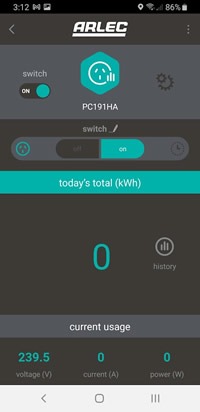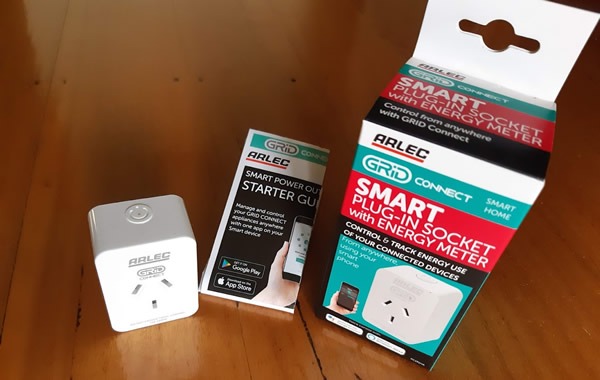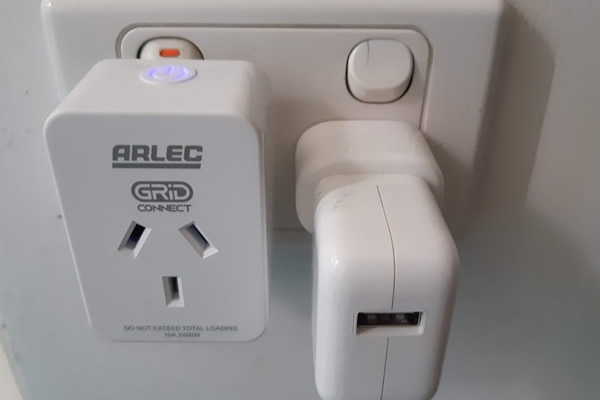Since Home Assistant introduced the energy dashboard, I have been playing about with the odd energy monitoring smart plug that I had in use and decided I needed to try a few more. I previously used TP-link sockets, but since this Alert I decided against using this brand again. When browsing the Bunnings website, I saw that they have a new range of cheap Tuya based Arlec Smart Plugs. Known as the Arlec Grid Connect Smart Plug-in socket with energy meter, this seems to be a smaller, upgraded version of a previous Arlec plug. At only $17.50 the price was too good to resist, so after stopping by a few stores, I eventually found one in stock, and proceeded to purchase it to try it out.
Unboxing
Size wise, this is one of the best smart plugs I have found in Australia. I have previously used Wemo and TP-link and both were too big to fit something in easily on the next socket. Smart sockets are getting smaller of late, I noticed Kmart also sell a very similar sized product to this Arlec unit under the Mirabella Genio Brand for $25. I imaging it would be a very similarly designed unit inside. As you can see in the pic below, the Arlec smart plug fits in a standard Aussie wall socket with plenty of room for a plug pack next to it or maybe even another smart plug.
Design wise, the Arlec PC191HA is a fairly plain white box (black is also available) with a single push button on top that has an indication LED under it. The unit is fully sealed, so there is no way to crack it open nicely to see the goodies inside. One feature that is on the plug that I have not seen before on other smart plugs is a default power on state option. This would be handy if using the device as an energy monitor on a mission-critical server or beer fridge.
Using with the Arlec Grid Connect App
The Arlec GRID Connect range of devices is Arlec’s branding for Tuya’s firmware and cloud offering for IOT devices. Tuya is a Chinese based company offering a white-label service for their cloud platform which allows smaller companies like Arlec to produce cheap products like this without designing their own backend. These companies can also repackage the Tuya app to focus on their branding and products without much fuss also and that is just what the Arlec Grid Connect app is, a cut down version of the Tuya app that will provide you with all that you need to control the Arlec range from the app itself or from Alexa or your Google Home. A nice option of the app is the ability to set up devices without requiring you to set up an account, something that many other smart home device makers insist you do before you can even use your device.
Setting up the device in the app was as simple as adding your 2.4ghz wifi details and holding the power button for 5 seconds until the LED blinks fast. The app found the device pretty quickly, and soon I was presented with a screen like below.
 If you only intend on using the device with your favourite voice assistant, then the Arlec app is a perfectly serviceable option.
If you only intend on using the device with your favourite voice assistant, then the Arlec app is a perfectly serviceable option.
Using with the TUYA app and Home Assistant
If you intend to purchase devices from other manufacturers that use a Tuya backend or, like me, you intend to use the device with Home Assistant, then you will need to set up the device with the Tuya Smart app.
The Tuya app is almost identical to the Arlec app but with a few extra features enable that we will need to connect Tuya’s cloud to Home Assistant.
To use with Home Assistant then you will need to set up an account for the Tuya app as well as another account on Tuya website. The full details to set up the devices with Home Assistant are on the Home Assistant website here. Once set up, any new purchased plugs will appear in Home Assistant automatically once they are connected to the Tuya app.
Important Notes when using with Home Assistant
When setting up the cloud connection on the Tuya site you need to select a data center region and there was none listed for Australia. If you get an error like “you cannot scan a QR to add a device deployed in another data center” then check your settings on the Tuya IOT platform site. After some trial and error, I ended up using Central Europe without an issue.
Once the device is added to Home Assistant, the 3 energy monitoring entities, Voltage, Current and Power are disabled by default in Home Assistant. You will need to enable them in order to use them, so go to configuration, integrations then select your device under Tuya to find the disabled entities.
Many plugs like these don’t generate a kWh sensor that we can add to Home Assistant’s Energy dashboard. Fortunately, you can create a conversion with an addition to Home Assistant’s configuration file, like below. Here I have taken my smart plug power sensor (renamed sensor.main_pc_power) measured in W and have converted it into a new sensor based in kWh. The utility meter section is also needed in order for it to show in the energy dashboard, This can take a few hours to become available to add once these have been added to your configuration.
sensor:
- platform: integration
source: sensor.main_pc_power
name: main_pc_energy_used
unit_prefix: k
round: 2
method: left
utility_meter:
main_pc_power_today:
source: sensor.main_pc_energy_used
cycle: daily
I have since purchased an extra four pack of these plugs, and the last one of the five I own was very stubborn to add to the Tuya app. It was not until I added it to the Grid Connect app and then repaired it to Tuya app that it would connect to the Tuya app.
Note that there are two pairing modes that are identified by a fast blink and a slow blink. The fast blink is for the default EZ config, while the slow blink represents the AP Mode, where you will need to connect your phone to the device’s “GRID-XXX” access point in order to pair. Holding the button for 5 seconds seems to toggle between the two modes.
Possibility of converting to non-cloud based firmware
Many people often talk of using a setup called Tuya-Convert to replace the firmware on these Tuya based plugs with something not cloud based like Tasmota or ESPHome. From what I have read it seems later versions of the previous model plug made this impossible and I can only assume this model would have beefier security. It also seems that this model doesn’t use an esp8266 chip that would even accept new firmware. According to the Tasmota Database, to do so requires replacing the Wi-Fi chip with an ESP based one in the device. I have not been able to open the device to confirm this, as they are well sealed shut, also I don’t believe it is worth the time and effort to do so.
Wrap Up
I am very happy with the Arlec PC191HA Smart Energy Meter. It is a great size, decent quality and a fantastic price. Given they can be configured officially to work out of the box with Home Assistant, they were a no-brainer to purchase considering the few other options available in Australia. Some people may be put off by the fact this is a cloud based device operated by a Chinese company, but I am ok with Xi Jinping knowing that I turn my heater on when it’s a cold day.
Home Assistant’s Tuya integration has been through a few revisions. What I am using here is the official Tuya integration maintained by Tuya and added in the October 2021 release of Home Assistant. Lots of improvements to the integration were also added in the November 2021 release and I would expect further tweaks and additions in the future, including a promised local control of Tuya based devices.
Resources
Single Arlec smart plug
https://www.bunnings.com.au/arlec-white-grid-connect-smart-plug-in-socket-with-energy-meter_p0273367
5 pack Arlec smart plugs
https://www.bunnings.com.au/arlec-grid-connect-smart-plug-in-socket-with-energy-meter-4-pack_p0273368
Home Assistants Tuya Integration page
https://www.home-assistant.io/integrations/tuya/
Note: The prices mentioned in this post were correct at the time of writing.

